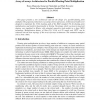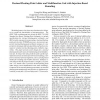36 search results - page 3 / 8 » Floating-point L2-approximations to functions |
ARVLSI
1995
IEEE
13 years 11 months ago
1995
IEEE
This paper presents a new architecture style for the design of a parallel floating point multiplier. The proposed architecture is a synergy of trees and arrays. Architectural mod...
CGF
2000
13 years 7 months ago
2000
We present a method for computer generated pen-and-ink illustrations by the simulation of stippling. In a stipple drawing, dots are used to represent tone and also material of sur...
ARITH
2007
IEEE
14 years 2 months ago
2007
IEEE
Shrinking feature sizes gives more headroom for designers to extend the functionality of microprocessors. The IEEE 754R working group has revised the IEEE 754-1985 Standard for Bi...
ASAP
2005
IEEE
14 years 1 months ago
2005
IEEE
With continued reductions in feature size, additional functionality may be added to future microprocessors to boost the performance of important application domains. Due to growth...
ASAP
2004
IEEE
13 years 11 months ago
2004
IEEE
Decreasing feature sizes allow additional functionality to be added to future microprocessors to improve the performance of important application domains. As a result of rapid gro...


